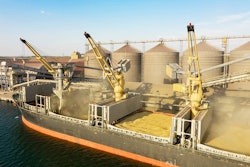
During theAgricultural Outlook Forum(AOF) on February 23,USDAreported its U.S. agricultural exports outlook for 2023.
The global economic outlook for 2023 has moderately improved since the last forecast in November 2022, as downside risks of recession have lessened. Inflation has begun to ease globally, particularly in the U.S., but remains elevated. Economic growth is expected to remain steady but at a slower pace than in recent years.
Export forecasts down for all commodities
USDA notes U.S. agricultural exports in fiscal year (FY) 2023 are projected at $184.5 billion, down $5.5 billion from the November forecast. The export forecasts for all major commodity groups are down, with the largest decreases projected for corn, sorghum and soybeans.
- Cornexports are forecast $1.9 billion lower to $16.6 billion on lower volumes.
- Sorghumexport projection is halved to $800 million on sharply lower U.S. production.
- Overall grain and feedexports are projected at $43.8 billion, down $2.4 billion from November.
- Soybeanexports are forecast down $800 million to $32.0 billion due to lower U.S. supplies and higher competition from Brazil.
- Totaloilseedand product exports are projected at $43.4 billion, down $900 million from the previous forecast; besides the reduction in soybeans, a lower soybean oil export projection is offset by higher expected soybean meal exports.
- Ethanolexports are forecast at $3.6 billion, down $600 million on lower volumes and reduced demand outlook.
Top U.S. export markets
- Chinais forecast to remain the largest market for U.S. agricultural exports at $34 billion, unchanged from the previous forecast.
- Exports toMexicoare forecast to remain unchanged at $28 billion.
- Exports toCanadaare forecast down $500 million to $27.8 billion on lower corn demand.
- FY 2023 exports to the third largest market,Japan, are projected $1.2 billion lower than FY 2022, due to lower expected corn, beef and tree nut sales
- Exports to theEUare also down slightly
- Forecast for exports toSouth Koreais on par with FY 2022’s levels.
U.S. agricultural imports in FY 2023 are forecast at $199 billion, unchanged from the November forecast, as increases in livestock, poultry and dairy, grains and feed, and oilseeds and product imports offset decreases in horticultural and sugar and tropical product imports.
USDA: Grain, oilseed prices down, but remain relatively high
Moderate global economic growth projected
World real gross domestic product (GDP) is projected to increase by 2.8% in 2023. Continental Europe’s economy has benefitted from a moderate winter, which has helped partially mitigate higher energy prices during most of 2022 due in part to Russia’s invasion of Ukraine.
China’s economic reopening from strict lockdown policies is expected to impact trade and increase global demand for some commodities, including oil. This may affect freight rates for ocean-bound cargo, which have continued to fall from their COVID-19 pandemic highs as supply-chain bottlenecks have eased.
最近美国劳工部的局of Labor Statistics data indicate that the uptick in inflation resulting from the COVID-19 pandemic economic disruptions has already peaked.
然而,通货膨胀率仍远高于U.S. Federal Reserve’s 2% target and are expected to remain above-target in the U.S. as well as in most developed countries throughout 2023 and 2024. Bringing inflation down through the deployment of higher benchmark interest rates will take time and is susceptible to disruption.
- Eurozone.Eurozone economic growth projection is 0.6% in 2023, lowered from 0.7% previously. Elevated food and energy costs have underpinned a cost-of-living crisis for many households. Falling real wages have led to labor strikes and other economic disruptions that threaten to hinder economic activity and growth.
- South America.South America’s real GDP is projected to grow by 1.2% in 2023, down from the previously projected 1.6%. Brazil’s is expected to grow 1.3% in 2023, raised from 1.0 previously. Peru and Colombia face slowing growth in the face of heightened inflation and elevated political uncertainty with a newly formed government for Peru and change in administration for Colombia. Chile’s economy also faces myriad challenges in 2023 including
persistent inflation, monetary tightening, and political uncertainty. - China.China’s real GDP is expected to grow by 5% in 2023, raised from 4.4% previously. The pivot away from restrictive lockdown policies is expected to substantially bolster economic growth and investment activity, although there remains a degree of uncertainty about China’s future COVID-19 containment policies and how it will participate in the global economy.
- Japan.Japan’s real GDP growth for 2023 is raised to 1.8% from 1.6% previously. More moderate inflationary pressures and less restrictive monetary policies are expected to be conducive for economic growth, as well as a return of the tourism industry with the border reopening to international visitors.
- South Korea.South Korea’s real GDP growth in 2023 is lowered to 1.9% from 2%, with economic growth slightly lower on continued tightening monetary conditions.
Imports adjusted upward
The agricultural imports forecast for FY 2023 remains unchanged from the previous forecast at $199 billion. This represents an increase of $5 billion above FY 2022 imports of $194 billion. Although the total import value is held constant from the previous estimate, the import flows have changed. Horticultural products as well as sugar and tropical products are revised downward, while livestock, dairy, and poultry, and — to a lesser extent — grains and feed and oilseeds and products are adjusted upward.
The FY 2023 forecast for grains and feed product imports is adjusted up $200 million, or 2%, from the previous forecast to $20.6 billion. This is due to reduced yields, high production costs, and tight inventories that have kept pressure on prices across grains and feed products, both in the U.S. and globally, despite some easing of prices — such as wheat — in recent months.
Tight conditions in the grain market further impact grain products, which include consumer food products, such as baked goods. In addition, the grain products have retained relatively high values and are responsible for much of the expected increase to the grains and feed product forecast.
The FY 2023 forecast for oilseeds and products is raised by $100 million from last quarter to $17.6 billion largely on increased imports of vegetable oils. This is due, in part, to the relatively tight domestic oilseed conditions leading to higher prices and expected increases in import volumes, especially canola oil. While canola seed imports are revised down this quarter, this reduction is more than offset by larger canola oil imports.






















